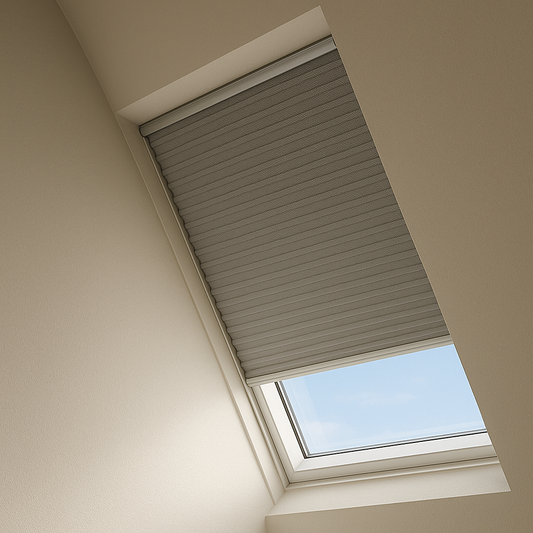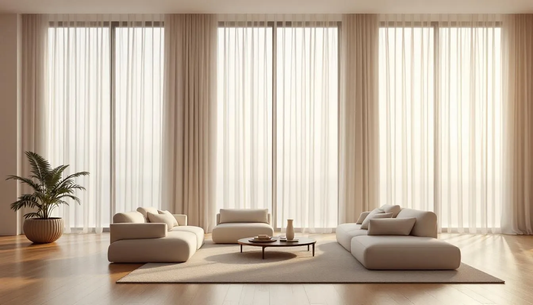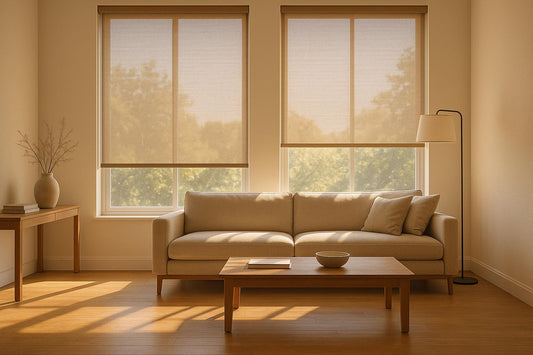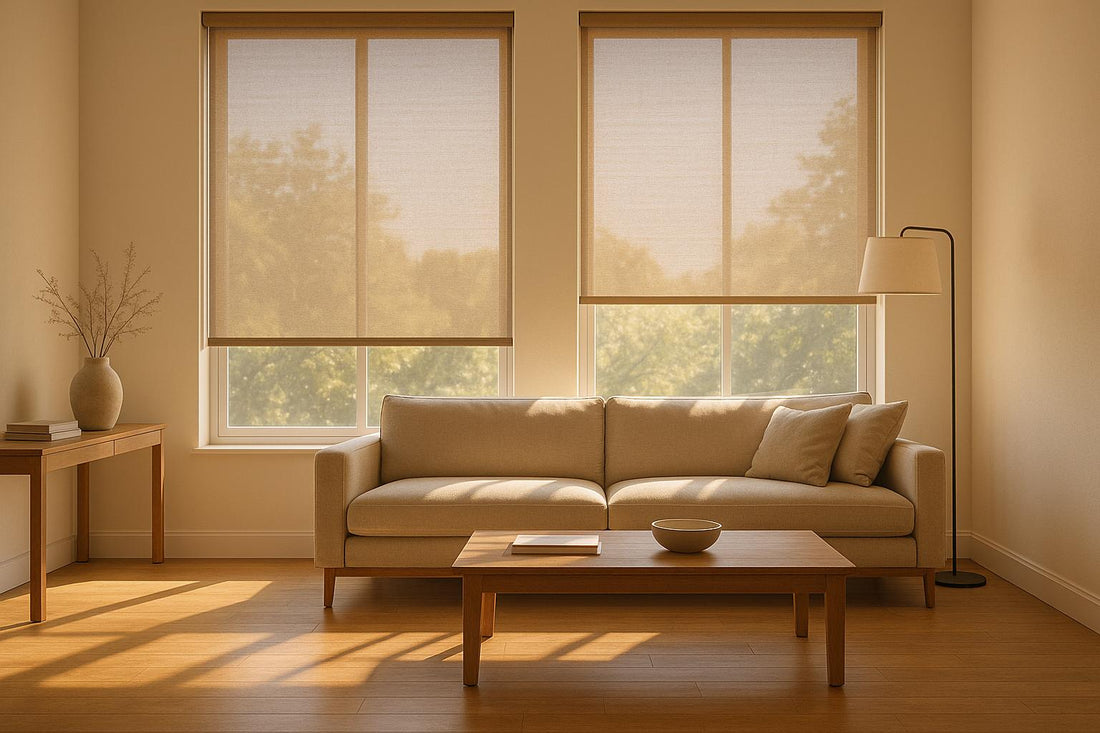
Solar Shade Benefits: Energy Savings Guide
Solar shades are a smart way to lower energy costs while keeping your home comfortable. They reduce heat from sunlight, block UV rays, and still let in natural light. Here's what you need to know:
- Energy Savings: Solar shades cut cooling expenses in summer by reducing heat gain and help insulate windows in winter to lower heating costs.
- UV Protection: They shield furniture and flooring from fading while maintaining visibility.
- Customization: Choose from different openness levels (1%-10%) to balance light, visibility, and energy efficiency for each room.
- Motorized Options: Automate shades for better temperature control and convenience.
Solar shades are easy to maintain and can last over a decade, making them a practical investment for long-term savings. Whether for intense sun or seasonal insulation, they offer a simple solution to reduce energy use and improve indoor comfort.
Solar Shades | What are they?
How Solar Shades Improve Energy Efficiency
Solar shades serve as an effective thermal barrier, helping to limit outdoor heat while easing the strain on your HVAC system.
Blocking Solar Heat and UV Rays
One of the main ways solar shades boost energy efficiency is by preventing much of the sun's heat from entering your home. Without them, glass windows can let in a lot of heat, forcing your air conditioner to work overtime.
Solar shades come equipped with a filtering layer that absorbs and reflects incoming solar energy. This means less heat builds up in your home, and you can still enjoy natural light without the extra energy costs. And here's the bonus: these shades aren’t just helpful in the summer - they also improve energy performance during colder months.
Year-Round Energy Performance
In winter, solar shades help by insulating your home. They create a buffer between the warm indoor air and the cold surfaces of your windows. This helps maintain a more stable indoor temperature throughout the year, reducing the workload on your heating and cooling system.
Many homeowners notice that rooms with solar shades experience fewer temperature swings. This can lead to less frequent use of heating and cooling equipment, which not only saves energy but may also extend the lifespan of your HVAC system. The result? A smoother, more efficient performance that could mean fewer HVAC cycles and lower energy bills.
Measuring Energy Savings
The exact savings you’ll see depend on factors like your local energy rates, home design, and how your windows are positioned. However, studies show that properly installed solar shades can significantly cut cooling costs and reduce heat loss in the winter.
In areas with strong sunlight or in rooms that get direct afternoon sun, the benefits of solar shades are even more noticeable. By reducing the load on your HVAC system and keeping your indoor environment more stable, solar shades can be a valuable part of your energy-saving plan.
Solar Shade Materials and Openness Levels Compared
The openness level of solar shades determines how much sunlight, UV rays, and outdoor visibility they allow. Choosing the right openness level can enhance energy efficiency and comfort in your home. Let’s break down how these levels impact performance.
Understanding Openness Levels
The openness factor measures the percentage of a shade's fabric that is open versus solid. This percentage affects how much light passes through, how well you can see outside, and how effectively the shade blocks UV rays. Openness levels typically range from 1% to 14%, but the most common options are 1%, 3%, 5%, and 10%.
- Lower openness levels (1% to 3%): These shades offer maximum UV protection and significantly reduce glare, making them ideal for areas with intense sunlight. However, they also limit outward visibility and create a darker indoor atmosphere.
- Higher openness levels (5% to 10%): These shades balance UV filtering with better outdoor visibility. They allow more light in while still providing some protection from harmful rays. Keep in mind, solar shades provide privacy during the day but are less effective at night when interior lights are on.
Openness Levels Comparison Table
| Openness Level | Light Transmission | Outward Visibility | UV Protection | Energy Efficiency | Best Room Types |
|---|---|---|---|---|---|
| 1% | Very Low | Minimal | Maximum | Highest | Bedrooms, media rooms |
| 3% | Low–Medium | Limited | High | High | Home offices, TV rooms |
| 5% | Medium | Good | Good | Good | Living rooms, dining rooms |
| 10% | High | Excellent | Moderate | Moderate | Kitchens, casual spaces |
This table highlights how different openness levels can meet specific room needs. For spaces like bedrooms or media rooms, a lower openness (1%) is perfect for reducing glare and protecting furniture from sun damage. In contrast, rooms like kitchens or casual living areas benefit from a 10% openness, which offers a clear view while maintaining some privacy.
When selecting shades, consider how much sunlight the room receives and the activities typically done there. For example, darker shades with lower openness are excellent for reducing screen glare in TV rooms or home offices. Meanwhile, shared spaces like living rooms and dining areas often benefit from a moderate openness level that balances light and visibility.
sbb-itb-f0eb538
Selecting and Customizing Solar Shades for Your Home
Choosing the right solar shades means balancing your home's specific sunlight exposure with your design preferences.
Assessing Your Home's Needs
Start by evaluating the orientation and sun exposure of each room. For instance, south-facing windows often get intense sunlight and may need shades that prioritize heat reduction. East- and west-facing windows deal with strong morning or afternoon sun, while north-facing windows typically have softer, indirect light, allowing for a mix of protection and visibility.
If your home features large picture windows or glass doors, keep in mind that these can let in more heat compared to standard-sized windows, making high-quality solar shades even more important.
Your local climate also plays a key role. In desert regions, where UV radiation and high temperatures are a concern, shades with maximum sun-blocking capabilities are ideal. On the other hand, homes in coastal or northern areas might focus on reducing glare or maintaining warmth during colder months.
Think about how each room is used. For example:
- Home offices benefit from shades that minimize glare on screens.
- Living rooms might require a balance of natural light and furniture protection.
- Bedrooms can be customized for either natural morning light or a darker, sleep-friendly environment.
Once you've assessed these factors, you can explore custom solutions designed to meet your home's specific energy and lighting needs.
Benefits of Custom Solutions from World Wide Shades
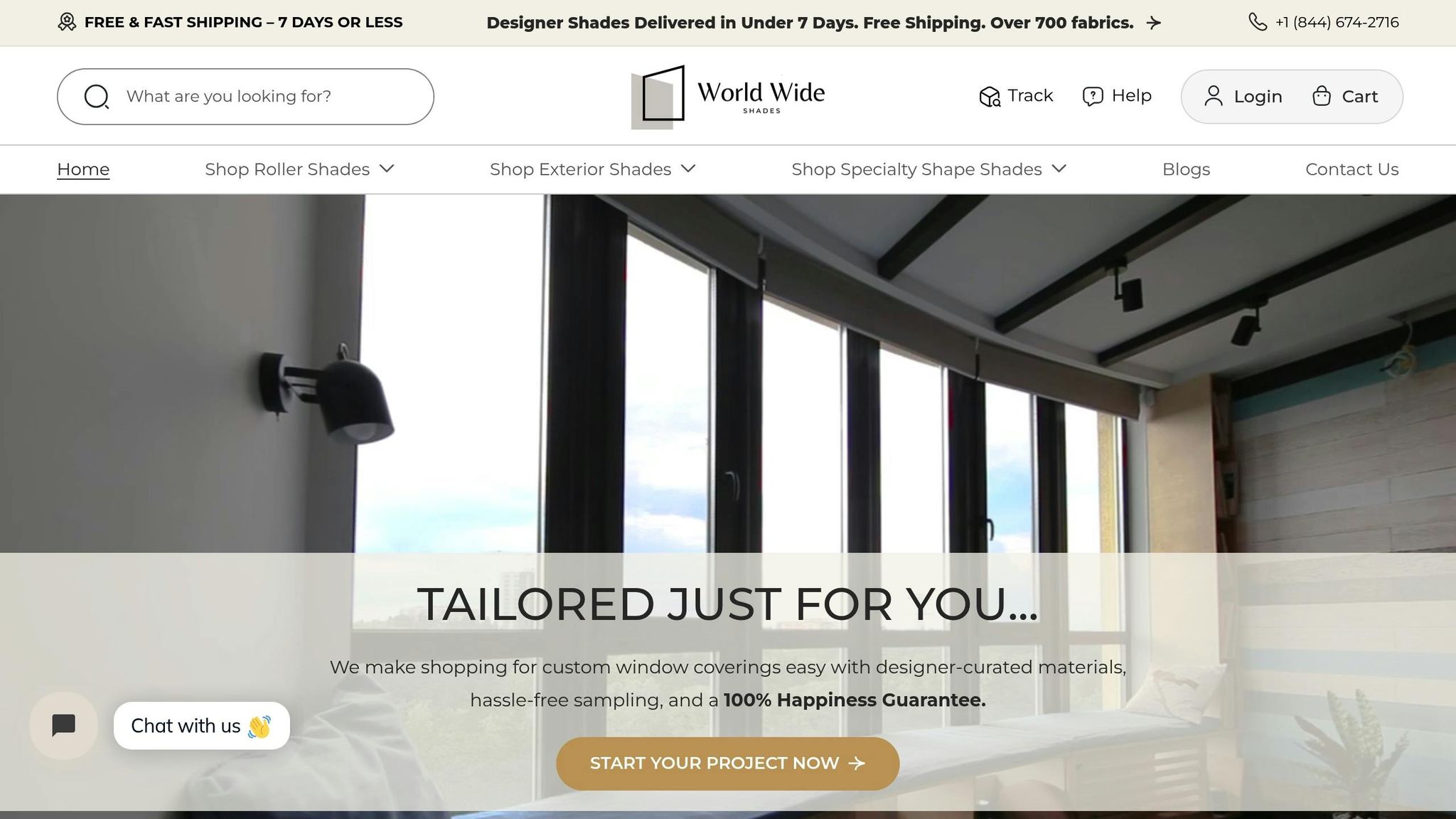
Customizing your solar shades ensures they meet the unique challenges of your space. World Wide Shades offers over 1,200 fabric options, allowing you to find the perfect match for both style and energy efficiency.
To help you make the best choice, they provide free fabric samples so you can see how different materials perform under your home’s actual lighting conditions. This way, you can test various openness levels and colors before committing.
Virtual design consultations are another great resource. These one-on-one sessions connect you with experts who consider your window orientations, room functions, and climate to recommend the most efficient materials and designs.
For homes with unique windows - like triangular shapes, skylights, or curved glass - custom shapes are available. Every product is handcrafted in the USA, ensuring precise customization and high-quality craftsmanship.
Adding Motorized or Smart Solar Shades
Motorized solar shades take energy efficiency to the next level by automating their operation. These shades can be programmed to adjust based on the time of day or real-time sunlight conditions, ensuring optimal energy performance with minimal effort.
The motorized options come with rechargeable battery systems, eliminating the need for wiring and making installation straightforward. You can even set up different zones to adjust shades according to seasonal sunlight patterns - for example, lowering them during peak heat hours and raising them when natural light is more desirable.
For those with smart home systems, solar shades can be integrated seamlessly. They can work alongside HVAC systems, adjusting automatically to help regulate indoor temperatures, or even respond to weather forecasts.
World Wide Shades offers motorized options for an additional $200 per shade, making this advanced technology a practical choice for homeowners looking to enhance energy savings and convenience.
Tips for Maximizing Energy Savings
To get the most out of your solar shades, regular maintenance is key. Keeping them clean not only enhances their look but also ensures they continue to provide energy efficiency.
Maintenance for Longevity
A quick wipe with a damp cloth is all it takes to remove dust and debris from your shades. This easy upkeep helps maintain the performance of their synthetic materials. With proper care, commercial-grade solar shades can last over a decade, consistently delivering energy savings throughout their lifespan.
Conclusion and Key Takeaways
Solar shades are a simple yet effective way to reduce energy use and keep your home comfortable by blocking solar heat. They help cut cooling costs in the summer and provide insulation during the winter. Here's a quick recap of why they remain a solid choice for energy-conscious homeowners.
The key is selecting the right materials and openness levels to strike a balance between blocking heat and letting in natural light. Tighter weaves offer more protection from the sun, while more open fabrics allow for better views. Tailoring your choice to each room ensures the best energy performance.
World Wide Shades offers custom solutions with over 1,200 material options to fit any space. Their motorized shades take convenience to the next level, automatically adjusting to changing sunlight throughout the day.
Solar shades aren’t just about comfort - they’re an investment in long-term savings. When installed correctly and cleaned occasionally, they can reduce HVAC strain, lower energy bills, and improve your home's overall climate control.
Whether you're dealing with intense sunlight, rising energy costs, or just want better control over your indoor environment, solar shades provide a practical, lasting solution. They’re a smart upgrade that pays off in both immediate comfort and long-term savings.
FAQs
How do solar shades improve energy efficiency compared to other window treatments?
Solar shades are a smart choice for boosting energy efficiency in your home. They help cut down on heat gain, reduce cooling expenses, and make the most of natural light. In fact, they can block up to 60% of solar heat, keeping your indoor spaces cooler and easing the strain on your air conditioning system.
Compared to other window treatments, like cellular shades, solar shades offer a unique balance of benefits. While cellular shades are great for insulation, solar shades excel at combining energy savings with light control. They let in natural light while keeping excess heat at bay, making them a practical and versatile solution for managing your home's comfort and energy use.
Can solar shades work with my smart home system, and what are the benefits?
Yes, solar shades can work effortlessly with your smart home system, adding both convenience and energy-saving benefits. With motorized solar shades, you can control them remotely or program them to adjust automatically based on your daily routine or changes in the environment.
For instance, you could schedule the shades to lower during the peak heat of the afternoon, helping to minimize heat buildup and reduce the load on your air conditioning. They can also pair with smart thermostats or be operated through a smartphone, making it simple to optimize energy use while keeping your home comfortable.
How do I choose the right openness level for solar shades in different rooms of my home?
When choosing the openness level for solar shades, consider the function of the room, the level of privacy you need, and how much natural light you want to let in. Openness is expressed as a percentage and determines how much light filters through the fabric:
- Low openness (1–5%): Blocks most light and UV rays while offering greater privacy. Ideal for bedrooms or any space where you want to minimize light exposure.
- Medium openness (5–10%): Strikes a balance between privacy and natural light, making it a great option for living rooms or home offices.
- High openness (10–14%): Lets in more light and maintains visibility, which works well for kitchens or areas where a bright, open atmosphere is preferred.
Darker-colored shades can also help cut down on glare while still maintaining a clear view of the outdoors. Think about your energy efficiency goals and the unique requirements of each room to make the right decision.

